
Artificial Constraints: A Primer on the MEC
For most of our nation’s history, the primary family savings vehicle was whole life insurance, for reasons we talk about ad nauseum on our podcast and in other content. Life insurance is treated differently (and vastly superior) in the tax code than are other financial products, surely due in part to the fact that life insurance in the United States pre-dates the tax code by around a century. Additionally, we know the tax code is written to incentivize behavior; the goal of reducing the public burden of retirement funding and dependence on the state later in life would be aided by increasing the prevalence of permanent life insurance (if you’ll grant the government the probably undeserved courtesy of acting in a manner so as to not create dependency). We will explore what changed to divert savings out of a superior product and into the icy waters of risk and speculation. Before we do that, however, we should refresh on the tax benefits of whole life, as they are what we must preserve in structuring policies for the infinite banking concept (IBC). The following are a few of the major tax advantages whole life enjoys; for brevity's sake, see the post-script for elaboration and exceptions that must be made in the name of transparency.
Cash value grows tax free, as it is simply the net present value of a guaranteed future non-taxable payment*
Accessing cash value by policy loan leaves the principal intact and is not taxable as income**
Dividends are not taxed***
Death benefit payouts to beneficiaries upon the inevitability of the death of the insured are not taxable
If the power of the IBC has fully sunk in as you’ve read and explored ours and others’ content, you recognize that a properly structured whole life contract is an ideal starting place for otherwise unallocated dollars flowing into your personal economy. It is reasonable to want to get as many premium dollars into the policy as absolutely possible. Further, given the immediate cash value generated by paid-up additional premium payments (PUA), you would naturally want the right to allocate as much of your annual premium to the PUA rider for liquid savings as desired (provided economic life value has been properly insured). So why can we not let you do that?
The Internal Revenue Service is why. And as we’ll uncover, the villain under the IRS mask in this case are those companies who could not compete on a level playing field. We are hamstrung a bit in our utilization of the most powerful financial tool because of lobbying efforts and the manipulation of market forces. Much has been written on the history of this ridiculous rule, wherein the Tonya Hardings of the financial world had to resort to foul play in order to maintain some semblance of relevance. I will summarize the background for those interested, though the 'why' and 'how' is not as important as the 'what' and the 'what now.'
A brief history of the MEC (for the nerds).
In an effort to not bore the reader beyond their current experience of reading about life insurance taxation, I will preface the insurance-specific part with an exceedingly generalized summary of a half decade of capital flow: in 1981, accelerated depreciation made real estate an attractive tax play; then Reagan’s 1986 Tax Reform Act extended that depreciation schedule of both commercial and non-commercial real estate, making it less attractive. (See, short and sweet!) As investors looked for new tax strategies, money poured into whole life insurance, which was already the primary household financial vehicle. Given its superior tax treatment, one could open a policy with a single large premium payment and capture a whole host of lifetime tax benefits. They could effectively shield that money from the bulging pig eyes of the tax man, retain access and control during their lifetime, and multiply the money at death for their heirs without taxation. Money in life insurance meant less money in inferior products, if consumers had their unencumbered choice.
The companies who could not compete on the merits of their own products complained that these consumers were not remaining true to the intent of life insurance. Rather than protecting beneficiaries upon their passing, they said, these consumers were obviously trying to avoid taxation, so they must be handicapped in their capitalization of such policies. (And so what if they were?! What is more American than exerting great effort to pay less taxes to a retarded bureaucracy which has usurped the Constitutional mandate of government for the people, and who daily defy their own constraints on money creation?). The financial turncoats realized they could not survive on their own if consumers were allowed to freely allocate their capital against the current taxation gameboard, so they got on their knees and held the pocket of their soon-to-be government protector, begging that the rules be changed to give them a chance at competing.
Aggressive Congressional lobbying by those sectors which were losing market share in the flock to whole life (mutual funds, term providers, etc) led to the Modified Endowment Contract (MEC) rules being implemented as part of the 1988 Technical and Miscellaneous Revenue Act (TAMRA). Among TAMRA’s thousands of pages was Section 5012, amending the text of IRS code § 7702 (which defined life insurance) as well as § 7702A (which defined modified endowment contracts). In other words, ‘don’t let them put that many dollars away, leave some for us.’ That mutual fund companies were given a voice in how consumers funded their life insurance policies speaks to the power of lobbying and the bureaucratic creep of the federal government over private contracts.
Yet given a voice they were, and the next decision was the flavor of weapon that would be used to shank the whole life contract. As life insurance watched helplessly behind a pathetically weak defense team, the weapon was debated and ultimately determined to be the ‘7-pay test.’ This test set an arbitrary minimum timeframe over which a policy could be paid up, before which it would lose its favorable tax status. So as to not venture too far into subjective analysis, let’s start with a review of the source documents before explaining what they mean to us as policyholders.
The technical stuff you can skip.
While TAMRA is the Congressional act that enacted this change, we will be focusing on IRS code § 7702, as TAMRA simply amended its verbiage to implement this charade of economic regulation. The first modification was to expand the definition of a MEC to mean any contract which met previous MEC criteria and,
(A) is entered into on or after June 21, 1988, and
(B) fails to meet the 7-pay test of subsection (b)
Relevant to point out is the grandfathering in of contracts dated before TAMRA which were not given this new treatment, as we often get questions about what would happen to in-force contracts if the government were to change the laws again. This should at least help alleviate that concern for current policyowners. More importantly, we now have a new test that all policies must pass if they are to retain the beneficial tax treatment of life insurance. The bill then defines the 7-pay test, whose precise text we will display before trying to parse through its meaning for the consumer:
(b) 7-PAY TEST. – For purposes of subsection (a), a contract fails to meet the 7-pay test of this subsection if the accumulated amount paid under the contract at any time during the 1st 7 contract years exceeds the sum of the net level premiums which would have been paid on or before such time if the contract provided for paid-up future benefits after the payment of 7 level annual premiums.
The next section covers when this 7-pay test will be conducted. Parsing through a several paragraphs to pull the applicable tripwires for the IBC practitioner, we find several instances where we need to be vigilant of the test. In addition to being run at the issue of the contract, it is also run if there is a reduction in benefit during the first seven years, as well as any time there is a material change to the contract.
The reduction in benefits matters to us because we use term riders to expand our ability to pay PUA premium, a strategy we will dissect below when we better understand the problem. While the term riders attached to a whole life policy for this purpose are convertible to whole life policies themselves, that is not why we attach them. The reduction in benefits tripwire highlights why this is likely not a prudent use of your contractual conversion right. If you decided you had enough of paying PUA and thought you could safely remove the term rider because you no longer require the same MEC limit, you would subject yourself to a new MEC test if done in the first seven years. That change would not apply at the date it is made, but rather would go back to contract origination date and compare premiums paid to the now lower 7-pay test. If you ever find yourself tempted to convert the term rider on your policy, rather than a companion convertible term standalone policy, please talk to your advisor first to make sure you won’t score the dumbest own goal ever.
The other applicable tripwire mentioned above is the material change clause. This clause appears open-ended enough to explain the lack of uniform understanding of the term ‘material change’ in the industry. The very unspecific definition of material change from the text is, “…any increase in the death benefit under the contract or any increase in, or addition of, a qualified additional benefit under the contract.” The text states that if there is a material change it will be treated (for purposes of the 7-pay test) as a new contract on the date the change takes effect, and the test will be run again. The lack of specificity merits the most conservative possible interpretation in order to not end up unintentionally “MECing” the contract. The obvious question is whether or not a PUA payment, which increases the future benefits (by adding death benefit to the policy), might count as a material change. We tend to assume that is the case, even if happens to not be in line with the practice of the issuing company, so that we keep MEC avoidance front of mind in all policy structure discussions.
The links to both TAMRA Section 5012 and IRS code § 7702 are provided in the footnotes for the reader who desires to parse through the documents themselves. For those who feel the background and context provided is sufficient, we can move on to what it means when a policy becomes a MEC.
The past is the past; what actually is a MEC though?
An endowment contract still leaves a tax-free death benefit to its beneficiaries, but it sheds the favorable tax treatment of the living benefits that are enjoyed by the non-MEC life insurance contract owner. Since we covered those favorable tax treatments above, we can just take the great things about the living benefits and strip them out to find out what a MEC means for you. Whereas before we enjoyed FIFO treatment on withdrawals, we now tax policy loans (and non-loan cash value withdrawals, which we should not be doing per IBC strategy) on a last-in first-out (LIFO) basis; any gains are withdrawn first and taxed as ordinary income before allowing contributions to be withdrawn. Whereas we had no restrictions on when we could access our cash value (for our purposes via policy loan), we are now hit with an early withdrawal penalty in addition to the tax for loans taken before age 59½, similar to a traditional retirement account. In essence, triggering a MEC by over-paying into a life insurance policy renders it as ineffectual as a traditional IRA or a 401(k), though it still retains its death benefit advantage over those vehicles. Finally, once a policy has been re-classified as a MEC, it is irreversible: ‘once a MEC, always a MEC,’ as they say.
Side box: There is a 60-day grace period offered to the insurance company when a MEC is triggered to allow them to refund the overfunded amount. You should, with the help of your advisor, work immediately to correct this situation if it were arise. Some companies won’t even allow you to pay more PUA premium than your policy room to take per your 7-pay premium, which is a great guardrail for us as policyholders.
Explain it to me like I took a vaccine for a free donut.
Translating the more technical portions above to something we can wrap our mind around, let’s recall the range of possible premium structure for a given death benefit. You could have a so-called ’10-pay’ policy wherein you paid premium for ten years at which point the policy is ‘paid up,’ or a ’20-pay,’ which would pay for the same death benefit over two decades instead of one. It should be obvious that stretching the premiums out an extra decade on a 20-pay while keeping the death benefit the same would make each premium payment necessarily lower than if the same amount of death benefit were paid for in half the time. Similarly, you could have a ‘paid-up at 65,’ where the premiums would be complete when the insured turns age 65, or a ‘paid-up at 95.’ Again, comparing these side by side, an extra three decades of scheduled premiums would necessarily entail lower annual premium for the same death benefit. Figure (1) depicts various premium schedules for the same death benefit.
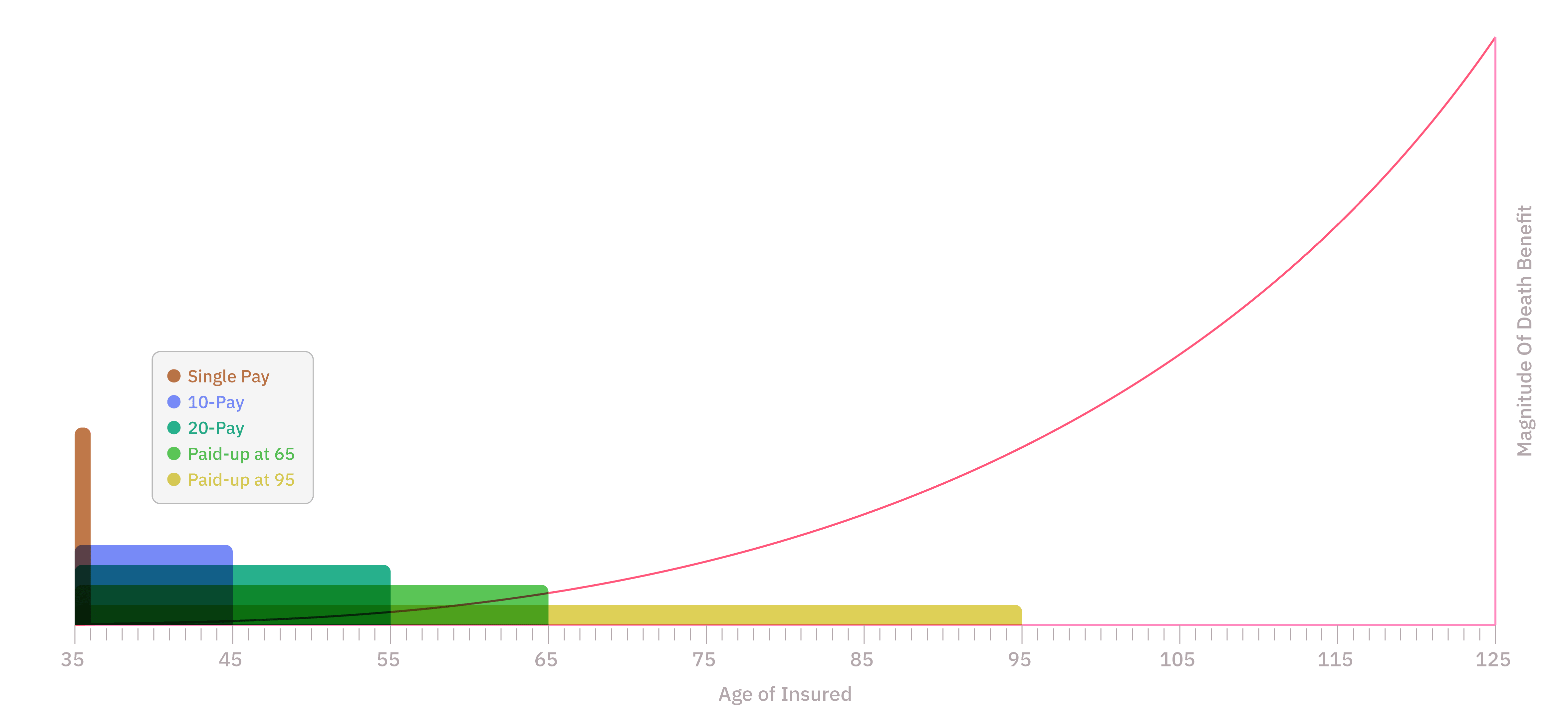
Figure 1: Visual Representation of Premium Schedules
[Note: This is a mathematically inaccurate depiction of how the total premium schedule might be graphically represented for the same death benefit, without any attempt to actually quantify the underlying dollar amounts. Again, for emphasis, please understand that this is solely a visual aid; the boxes drawn to represent different premium schedules do not correspond with any actual numbers, and the relative sizes of the boxes is not to any measurable scale but merely for visual effect.]
With that caveat, here is how I visualize what is happening when we think through MEC avoidance. We see the death benefit on the right axis, a single line whose magnitude corresponds to an undefined dollar amount of future tax-free death benefit. The curved line represents the growth of cash value over time, which we know must one day (at age 121) exactly equal its future value (the death benefit). Finally, we have various payment schedules which are spread out over their prescribed timeframes. This 35-year-old could pay till they are 95, till 65, for twenty years, or ten. There is also a single pay premium that is shown, the likes of which were popular before the MEC rules went into effect. The takeaway here is that the more compressed the timeline of the premium schedule, the more each premium payment must necessarily be for the same death benefit.
Now we can begin to understand the “7” in the ‘7-pay test.’ Start with any death benefit and a premium schedule. Whatever the death benefit is, over the prescribed premium schedule, what would be the amount of total annual premium which would render it paid-up in a seven year timeframe? That becomes what some companies quote as the ‘7-pay premium.’ For example, we might plan to pay premium until age 95 for a $1m death benefit; if we were to instead take that entire timeline of premium and compress it into seven years, such that those seven payments would fully pay for the $1m death benefit, you would know your annual 7-pay premium. If you were to surpass that line in any year of the seven, the policy would become a MEC, rather than traditional life insurance.
I still don’t see why I should care...
We now have a basic grasp on what a MEC is and why we want to avoid it, but why do we care if we are planning to pay till we’re 95? You're not trying to pay it off in seven years, so you're all set, right? In a standard whole life policy, with base only premium, it is not a factor. Recall that base premium purchases the bulk of the death benefit in policies we structure for IBC. In a non-IBC policy that is all base, the base premium purchases the entire death benefit and cannot be paid early anyways. But we need to refresh on what paid-up-additional (PUA) premium is and how it contributes to the death benefit in order to understand the MEC risk it incurs.
When we purchase PUA, we are in effect establishing a new (small) policy that is fully funded upon going in force. The amount of death benefit that each dollar purchases depends on age and rating, but for example’s sake we’ll ballpark 3:1, such that a $10,000 PUA premium payment would add $30,000 of death benefit to the policy. Because no more premium is required to fully pay up that death benefit, contrasting to our base death benefit which has a long schedule of remaining payments in order to be paid-up, this $10,000 is available as cash value immediately and (almost) in full. There is a small cost to put $30,000 of coverage in force, which is actuarially determined by each company; that amount is in the ballpark of 5% but can be as much as 15%. For our preferred companies, we can expect that $10,000 PUA will translate to approximately $9,500 of available cash value within a few weeks of going in force. That is a fundamental tenet of a policy structured for IBC as it overcomes the initial ‘cash drag’ of the base premium, allowing an IBC practitioner to enjoy access to a sizeable portion of their total premium in the early policy years while the base premium is not yet substantially contributing to cash value growth.
The downside of that very favorable element of PUA premium is the ratio of premium input (which counts towards the total 7-pay premium) to death benefit purchased. It might help to pause here and move from hypothetical to actual numbers for those who have trouble tracking the conceptual discussion. I will put up my own whole life policy numbers here so that we can see this premium to death benefit distinction using actual data. My annual premium is $50,000 of which approximately $14,200 is base premium, $34,500 is PUA premium, and $400 is the term rider. The leftover goes to the waiver of premium rider, but that is a discussion for another article. Here is an actual screenshot from my illustration that breaks down my premium; moving forward note that I am rounding each value to the nearest $100 for simplicity's sake.

We can see the base premium of $14,200 puts in force $565,000 worth of death benefit; the $400 term rider puts in force $300,000 of death benefit; the death benefit put in force by the PUA premium of $34,600 is not shown here because, remember, PUA does not have to be paid. But if we look at the guaranteed death benefit after one year, elsewhere in the illustration, we find that if we did pay the PUA we would have $946,600 total death benefit. Subtracting the other two values, we calculate that the PUA, if paid as illustrated, would generate about $82,000 in death benefit. Seeing these premium inputs, and the corresponding death benefit each instantiates (puts in force), should underscore the points being made in this article about how they contribute differently to both the death benefit and the cash value. Here is a graphical comparison of those two factors. As we review both graphics, keep in mind that the color coding is consistent among them- blue is base, orange is PUA, and green is term. Things should be clicking now when we observe such disparate results from these values.
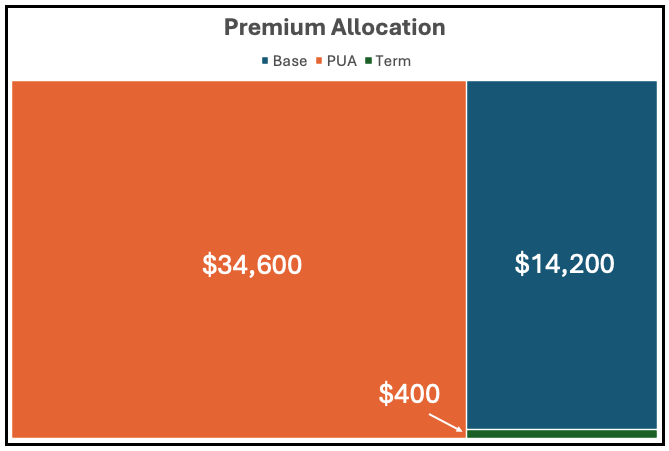
Starting with premium allocation, we see that around 70% of the total annual premium is allotted to PUA (orange). Base (blue) makes up most of the rest, with a tiny sliver of term (green) squeezed in there. That term component is so small as to seem irrelevant, until we see the death benefit it generates on the next graphic.

This graphic shows a very different breakdown of the three components. While our PUA (orange) was a very large portion of our total premium, it instantiates the smallest amount of death benefit. Compare that to the term (green) component, which was barely visible in the premium breakdown, but several times larger than the PUA portion when it comes to death benefit. Finally, notice that our base premium (blue) is around 60% of total death benefit. When we see the components broken down in this manner, we are better equipped to move forward in our discussion of the MEC. As we move away from actual numbers and back into the theoretical realm, come back to this section to revisit these numbers if you start to lose track of the hypothetical walk-through.
Let’s go back to the premium schedules from Figure (1) and zoom in on the first part of the graph, highlighted in Figure (2). Tying it back to the real numbers example, each year in the graph below would be the total annual premium, while the death benefit on the right x-axis would be the total death benefit in force. At this point, we are talking about only base premium, as that is our starting point from which we will expand as desired.
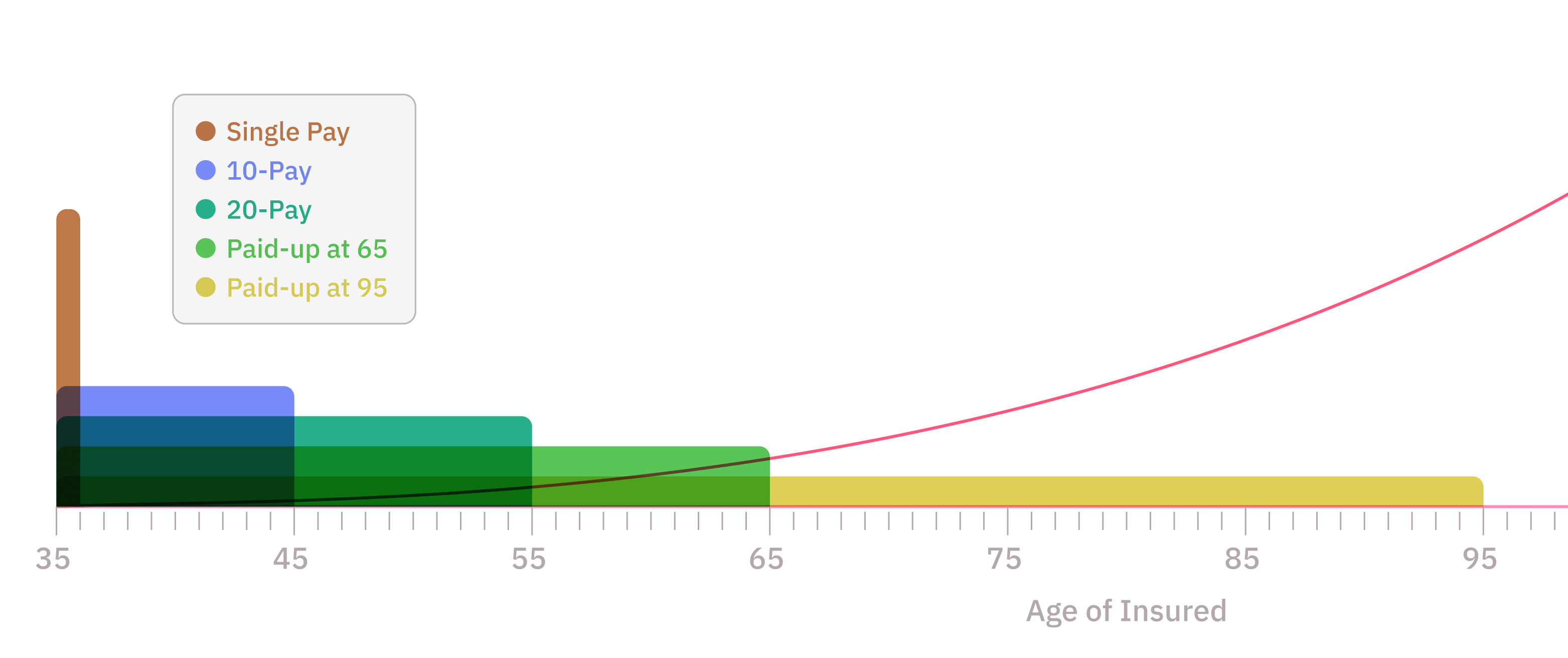
Figure 2: Magnified View of Premium Schedules
Our job now is the find the 7-pay premium. We know the IRS will be finding the amount of premium that would pay for this policy in seven years, so I think of the 7-pay premium as another ‘box’ of total premium on the graph. If the blue box represents a ’10-pay’ (paid up in ten years), we can easily approximate where a theoretical ‘7-pay’ would fit on the graph: somewhere between the single pay and the 10-pay boxes. Figure (3) shows our hypothetical box- not as high as the single pay in magnitude, not as long as the 10-pay on the timeline x-axis. Remember that we are still talking about the base premium required for same death benefit across all premium schedules, without adding any term or PUA premium to alter the size of the 7-pay box. Here is what our new 7-pay box might look like:
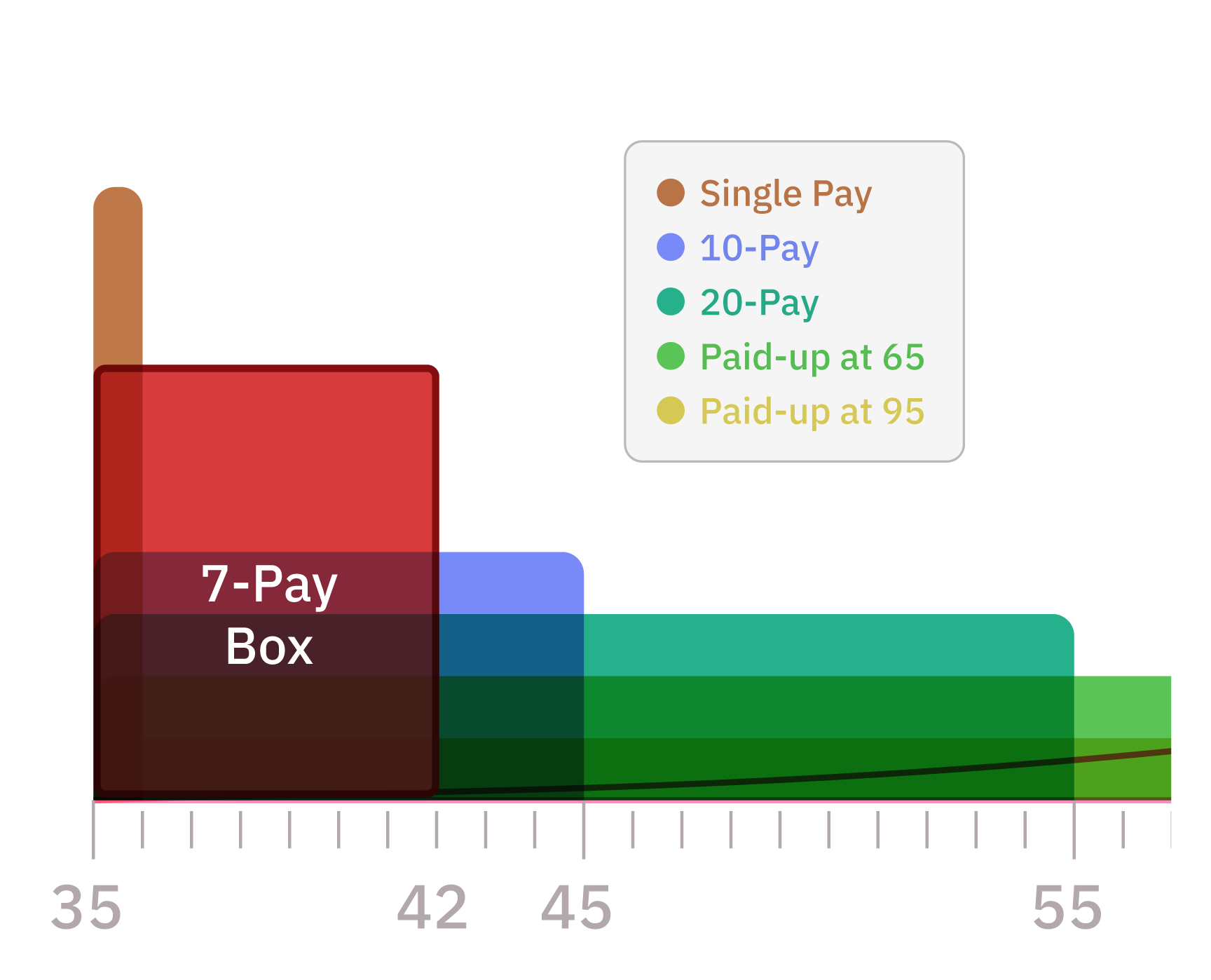
Figure 3: Adding the 7-Pay Premium Box
Next, we’ll isolate our hypothetical 7-pay box in Figure (4) to better visualize the concept. This box shows the annual maximum premium we could pay in each of the seven years without crossing the MEC line. While we are still talking base only, in reality we know we want to pay PUA premium as well in order to practice IBC. Figure (4) is kind of blending these two realities, showing non-constant premium amounts paid each year. Just try to focus on the relationship between death benefit and total 7-pay premium for now. If we imagine each year to have an equal max premium that would pay for the policy in these seven years, then every premium dollar paid in a given year will incrementally fill that year’s allotment, as illustrated below.
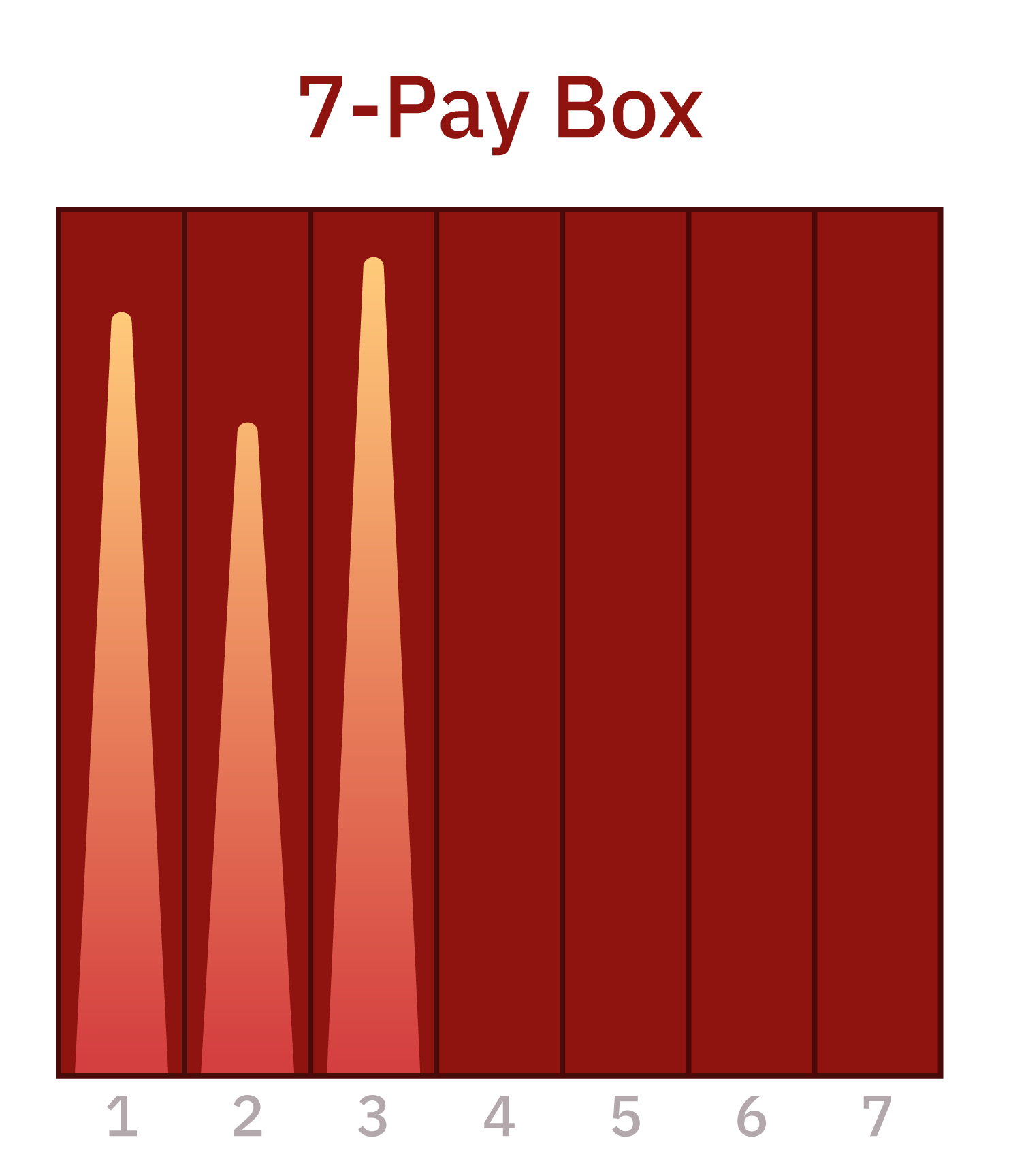
Figure 4: Magnified 7-Pay Premium Box
We can deduce that adding any type of death benefit would grow the y-axis (increasing the magnitude of death benefit), necessarily expanding each premium schedule box in a manner corresponding to the degree of death benefit growth. Figure (5) shows an increase in the death benefit and its subsequent impact on the size of each premium box.
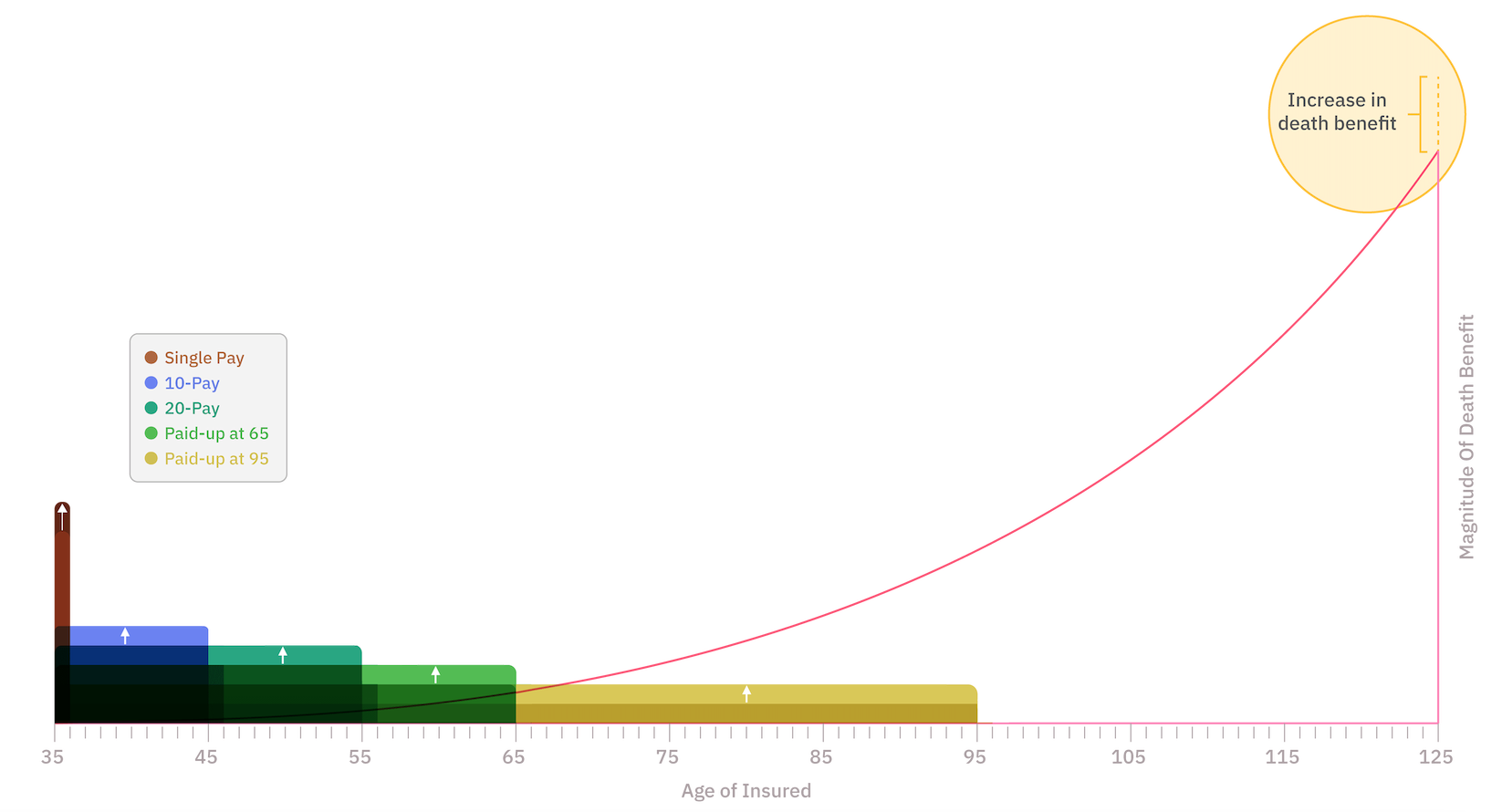
Figure 5: Increased Death Benefit’s Impact on Premium Schedules
We next imagine our notional 7-pay box expanding along with the others, isolated in Figure (6) below. The upper boundary of the box represents our actual MEC limit, whether that is the original confines of the box or the resulting higher boundary due to death benefit expansion; the bars in each year indicate premium paid that year. Notice how the expansion of the box (via increased death benefit) would allow for more total premium input each year without crossing the MEC limit. The question becomes: what can we do to expand that box, and how much impact do different tactics contribute to expansion?
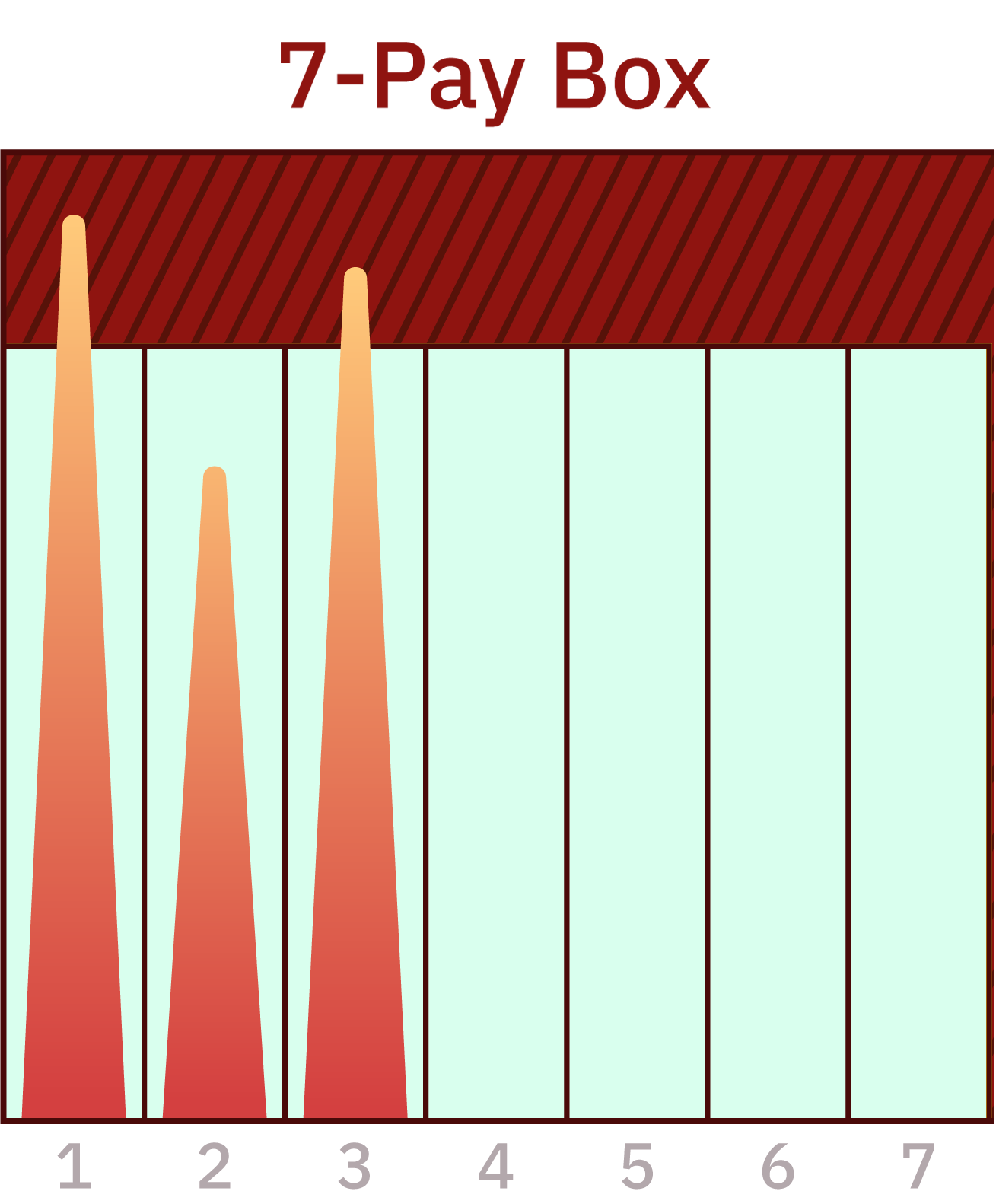
Figure 6: Increasing the size of the 7-pay box
This is where the ratio of premium input to death benefit output which is derived from a PUA payment demonstrates its disadvantageous impact on the 7-pay premium box. Recall our previous example from my own policy. My PUA premium of $34,600 only put $82,000 of death benefit in force. So applying that to the image above, we only increase the size of the 7-pay box by a small amount, but in doing so we put a lot of premium into the annual policy allotment. Put another way, PUA payment consumes an outsized percentage of our total annual premium allowed, while contributing little to the necessary expansion of the 7-pay box. A dollar of premium paid, whether base or PUA, counts the same towards the annual maximum, which is why we find ourselves quickly approaching the MEC line in a high PUA policy, if no other action is taken. We know we want to expand the box, and we know PUA death benefit does not do enough to build us the premium payment ability we need, so we must use other measures.
How do we counter these conflicting outcomes when designing a policy? After all, we want the early cash value growth and access that PUA provides. The reason that IBC is such a powerful concept is not only that the contractual rights exist, but that we can enjoy their benefits immediately and continuously during both our accumulation and distribution phases. So we need to find something which has the opposite effect as PUA to the 7-pay box: it contributes outsized death benefit for a very low premium outlay.
As we know from the real numbers example, the answer is of course term insurance, specifically a term rider. The aim of typical insurance shopping, seeking the most coverage for the least premium outlay, is antithetical to the IBC mindset when it comes to policy capitalization. Yet in this use case, it is exactly what we need to expand the size of that 7-pay box without gobbling up correspondingly large chunks of premium. Since term premium brings no benefits to the table besides the rented death benefit if one were to die while the term was in force, we want as few term premium dollars taking up 7-pay space as possible. But we do need to have some measure of it in order achieve most policy structures. While a 50/50 policy (half base, half PUA) likely has enough death benefit from such substantial base premium so as to preclude the need for term, as we skew the ratio in favor of PUA, we increase our need for ‘artificial expansion’ of the 7-pay box.
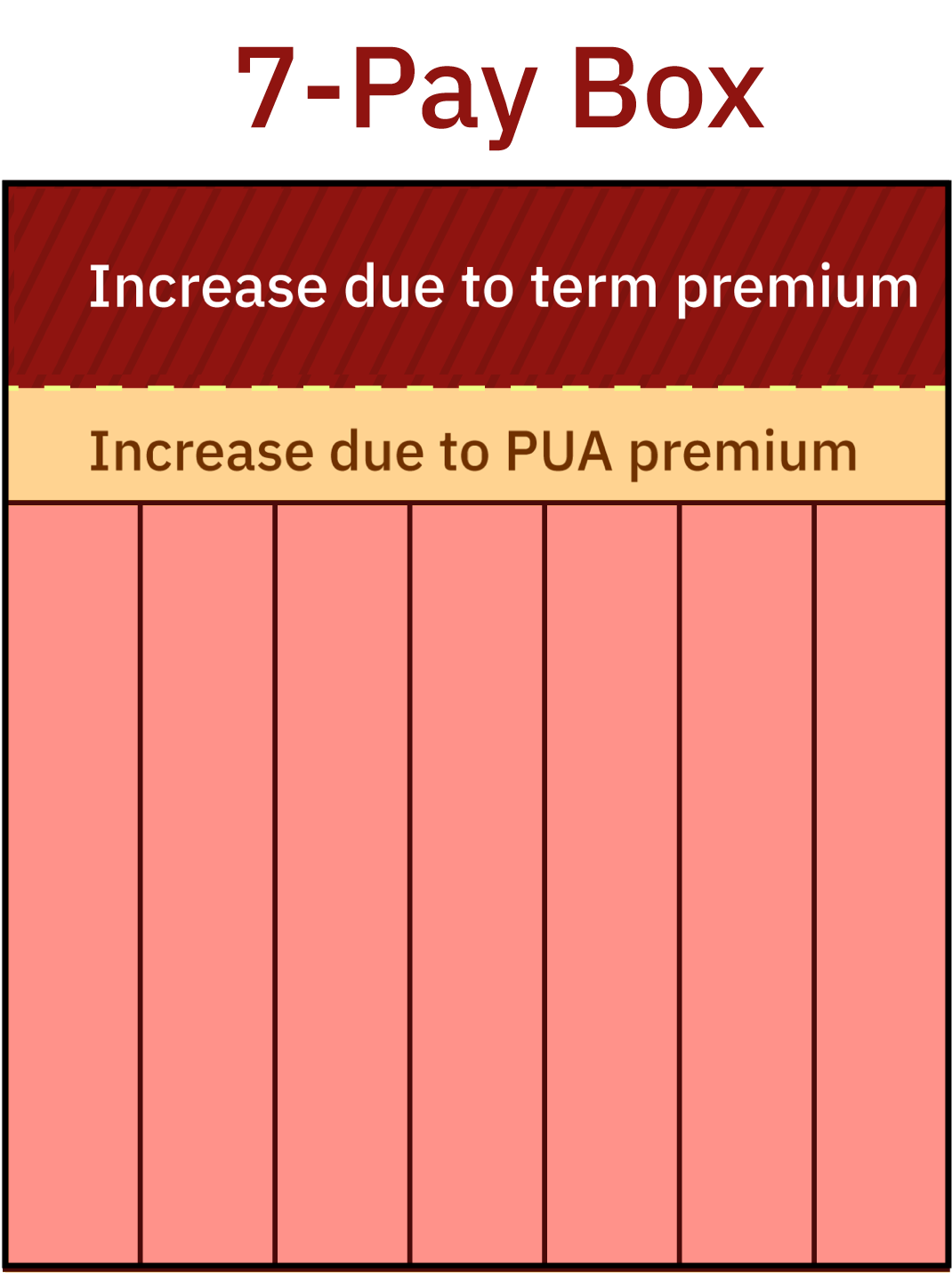
Figure 7: Increasing the size of the 7-pay box
Recall Figure (6), which showed what increased death benefit, however that happens, might do to our 7-pay box, we can see how the expansion allows for the total amount payable each year to increase uniformly. To further examine how that box might grow, Figure (7) shows the contrast in expansion due to death benefit purchased by PUA premium versus that of term premium. As we know from seeing real numbers, this image is not to scale, as the PUA increase would be much smaller, perhaps barely visible, relative to the size of the box. This image is to show that term yields a larger benefit, and is not true to the real numbers.
The final step in this visual walkthrough is examining the premium amount itself so as to view the different types of premium in proper proportion. Figure (8) below depicts how the three types of premium input (base, term, and PUA) might comprise a total annual premium outlay. Notice the base and term are consistent across the years shown, as they are fixed amounts (base for the entire schedule, term for the duration included in the contract). PUA, however, varies in this graphic, reflective of the option to pay any amount or all of the allowed premium towards that rider. Remember, we want the right, but not the obligation, to pay as much PUA premium as possible. The use of term death benefit as outlined above is what affords us the right by expanding our 7-pay box.
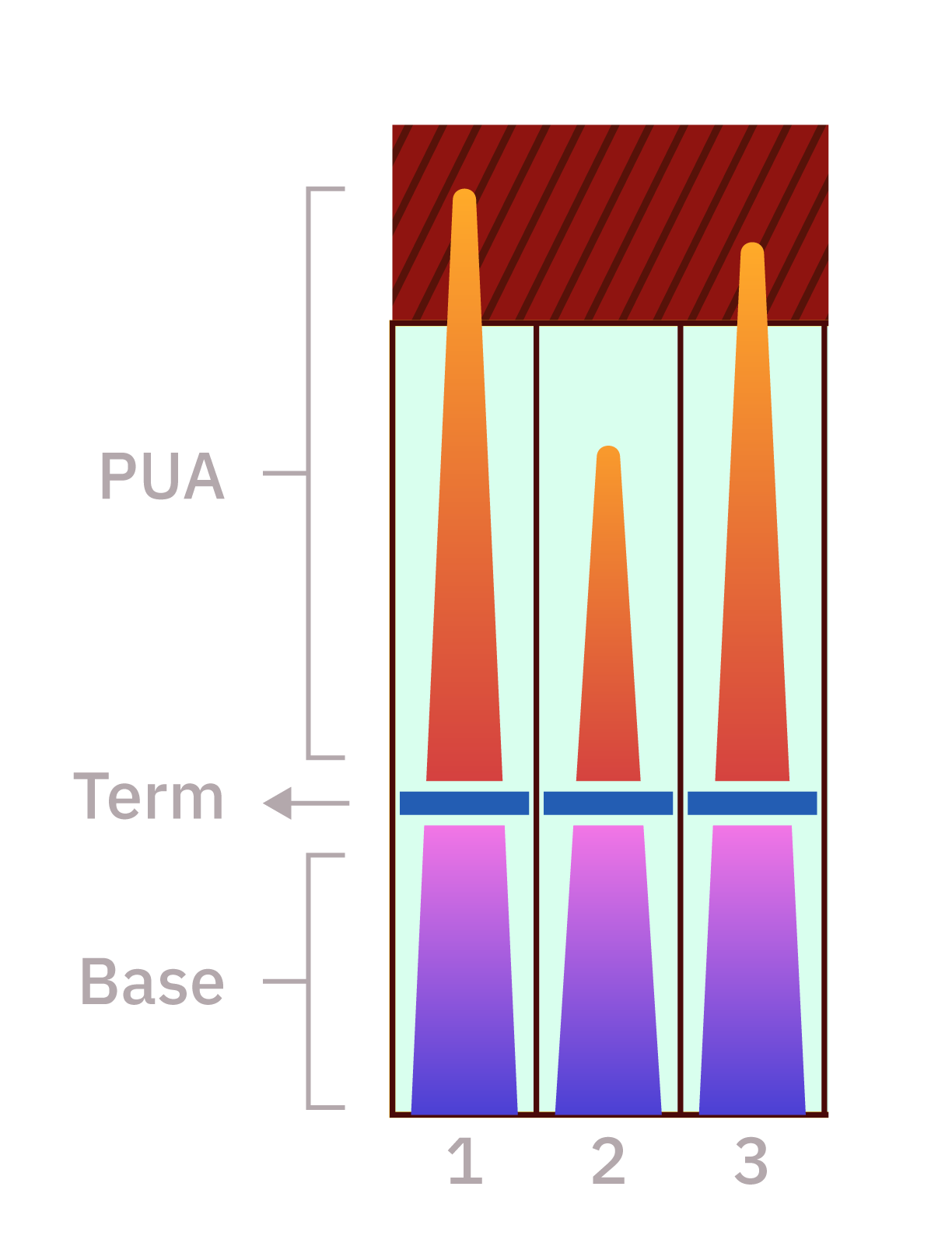
Figure 8: Premium Structure
Notice how removing a small sliver of total premium (the blue term portion) would collapse our 7-pay box down to its original size as determined by the base policy. Doing so while keeping the premium outlay as shown would clearly result in the policy becoming a MEC, as years one and three in our example both paid more than the initial MEC-test (without the term coverage expanding the allowable premium) would have allowed for.
That was a phenomenal explanation. Is there anything else worth noting as I design my policy?
When we know our 7-pay number, we have the upper limit of how much premium we can put in the policy each year. That amount is not cumulative over a seven year period, rather each year is capped at one-seventh; in other words, the 7-pay premium amount you see quoted on the illustration would be the max for each year. If that number were $42,000, for example, you could not pay $40,000 in one year and $44,000 in the next to average $42,000 over that two year stretch. If you ‘break the plane’ of the MEC line in any year, it becomes a MEC, and you need to work with your advisor immediately to help the company refund the excess premium within the allowed window.
This should also help make clear why the low base, high-PUA policies that are popular on social media, often called ’90-10’ policies (90% of total premium allocated to PUA, 10% to base) are destined for MEC status unless they are castrated earlier than intended. If 10% of your premium is putting substantial death benefit in force on a per-dollar basis, while 90% is instantiating very little relative death benefit, you are limiting the size of that 7-pay box. The lower you dial down the base, the smaller you make the 7-pay box, and vice versa. It is very shortsighted to be awed by very aggressive cash value growth pitches (“I can put in $40,000 PUA today and have access to $36,000 right away!”), as you will not even make it to that seven year mark before you have to drastically reduce PUA payments that are eating up the premium room in that small box. This is why we refer to base premium as the foundation of the policy. Pour a one foot concrete foundation and it sets quickly, but the amount that can be built on it is very limited before it topples over for lack of support. Conversely, pour a twenty foot concrete foundation and it takes longer to harden and be ready to be built upon; but the structure that can be built on top of it will greatly outlast and outperform its shallow foundation counterpart.
Is There an Upside to a MEC?
We know why we as individual policyholders who are implementing IBC in our personal family economy do not want a MEC, but are there scenarios where the negative implications of a MEC might be mitigated or eliminated entirely? Well, if adverse tax treatment is what we are trying to avoid, we might look to policy owners who do not pay taxes. This would include charitable and religious institutions, among others. While there must be a human life that is insured, the owner and payor of the policy can be any entity- a corporation, a charity, another human, the insured themselves, etc. So if you are using a policy for infinite banking as a 501(c)(3), for example, you might not care if the policy becomes a MEC because the adverse tax treatment already does not apply to your organization.
If you put this in the lens of a church for instance, imagine the power of applying tithes to a policy on the life of the pastor or an elder. The capital remains accessible, and because we can MEC the policy without incurring adverse tax treatment, we can generously fund the PUA rider to a degree that would be unwise for the taxed individual. All the tenets of IBC would apply to this church’s policy, such as accessing capital that grows guaranteed over the entire life of the insured. Then when that individual inevitably dies, the death benefit that is multiples of the premium put into the policy, can pass tax free to the churches coffers. Imagine your church never needing to do a funding drive for a new building because years of prudent capitalization has yielded a deep pool of cash value that is accessible by the policy holder. Alas, the disparagement of whole life insurance by financial entertainers who know nothing of the powerful contractual rights it entails has deeply rooted itself in the church culture. This means the obvious solution to most of your church’s financial woes is unlikely to be implemented without a serious financial unlearning by those controlling the purse strings.
Understand what you have.
This walk through of what a MEC is, why we want to avoid it, and how we do so is intended to be a primer on a very important topic. If you don’t feel like you could explain the content to someone else, read through it again, or reach out to us at [email protected] to further explore the concept. This is the process of becoming your own banker, and we want our clients to be fully knowledgeable on all aspects of the system. We are very intentional in the way we structure policies, and MEC avoidance is one of the primary considerations in creating a policy that meets your capitalization goals. We are always able to run an in-force illustration to put your mind at ease, but our goal in working with you is that you are able to explain the elements of your policy and why they work together to avoid a MEC. You do not need to trust the experts, or even to trust us for that matter. You are capable of understanding and implementing this concept with a sufficient base of knowledge, and we strive to help you get there. Onward!
Post-script:
*Technically it is correct to say that cash value grows tax-deferred, as there is a way it could be taxed upon access; this would be if polcy either lapsed and the cash surrender value was higher than cost basis, or if the policy were to become a MEC, as this article discusses; a properly structured policy and utilization plan mitigates this possibility.
**Even if one were to withdraw cash value, it is afforded first-in, first-out (FIFO) treatment, meaning that contributions (non-taxable) can be withdrawn before gains (taxable); this is not something we do when practicing IBC but is nonetheless superior tax treatment relative to most other products
***Policyowners of whole life with mutual companies (the only ones we use for IBC) are the recipients of company surplus; these pro rata dividend issuances are not taxable up to cost basis if taken as income, though we use them to purchase more PUA premium which also incurs no taxable event
